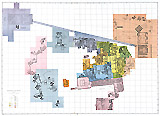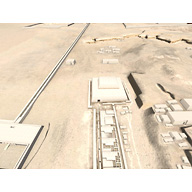Central Field (Hassan): Site: Giza; View: G 8400
-
- Tomb Owner
- Khentkaus [I] (G 8400)
-
- Excavator
- (Karl) Richard Lepsius, German, 1810–1884
- Selim Hassan (Bey), Egyptian, 1886–1961
-
- Lepsius No
- Lepsius 100
- L.100
- LG 100
-
- Hassan No.
- Khentkaus [I]
- Pyramid Complex of Queen Khent-kawes
-
- Khentkaus Pyramid
-
- Abou-Ghazi No (ASAE 58 [1964])
- 66
- 67
- 68
- 69
-
- PorterMoss Date
- End of Dyn 4 or early Dyn 5
-
- Site Type
- Stone-built mastaba complex
-
- Remarks
- G 8400 (also known as Lepsius 100 or the ‘Pyramid’ of Queen Khentkaus) is southwest of the Sphinx in the southern portion of the Central Field, west of the area known as the Khentkaus Town (or Khentkaus Pyramid Town), east of G 8310 (Lepsius 94), and northwest of the Menkaure Valley Temple. According to excavator Selim Hassan, the pyramid complex of Queen Khentkaus includes the ‘Pyramid’ (A-G No. 66), Solar Boat (A-G No. 67), Valley Temple (A-G No. 68), Washing-tent (A-G No. 69), House of Embalming, and libation tank. The so-called Valley Temple refers to the ante-temple area of the Menkaure Valley Temple. The associated mud-brick Khentkaus Town lies to the east. Excavated in 1932-1933 by Hassan.
-
- EMC_JE_72355b
-
- EMC_JE_72355i
-
- EMC_JE_72355h
-
- EMC_JE_72355e
-
- EMC_JE_87938
-
- EMC_TR_25.5.47.11
-
- EMC_JE_87929
-
- EMC_JE_87931
-
- EMC_JE_87932
-
- EMC_JE_87933
-
- EMC_TR_25.5.47.5
-
- EMC_TR_25.5.47.6
-
- EMC_JE_87934
-
- EMC_JE_87935
-
- EMC_JE_87936
-
Faience amulet of cat and kittens
- EMC_JE_87937
-
- EMC_JE_88176
-
- EMC_JE_88177
-
- EMC_JE_88164
-
- EMC_JE_88165
-
- GEM_31065
-
- EMC_JE_87950
-
- EMC_JE_87951
-
- EMC_JE_87952
-
- GEM_3659
-
Faience udjat (eye of Horus) amulet
- EMC_JE_88161
-
Faience udjat (eye of Horus) amulet
- EMC_JE_88162
-
Faience udjat (eye of Horus) amulet
- EMC_JE_88163
-
Faience udjat (eye of Horus) amulet
- EMC_TR_25.5.47.18
-
Faience udjat (eye of Horus) amulet
- EMC_TR_25.5.47.19
-
Faience udjat (eye of Horus) amulet
- EMC_TR_25.5.47.20
-
- EMC_TR_15.5.46.10A
-
- EMC_TR_15.5.46.10B
-
- EMC_TR_15.5.46.10C
-
- EMC_TR_15.5.46.10D
-
- EMC_TR_15.5.46.10E
-
- EMC_TR_15.5.46.10F
-
- EMC_TR_15.5.46.10G
-
- EMC_JE_72355a
-
- EMC_JE_72355d
-
- EMC_JE_72355c
-
- EMC_JE_87920A
-
- EMC_JE_87920B
-
- EMC_JE_87920C
-
- EMC_JE_72364
-
- EMC_TR_25.5.47.14
-
- EMC_JE_72355f
-
- EMC_TR_14.5.46.3
-
- EMC_JE_87955
-
- EMC_JE_87956
-
- EMC_JE_87957
-
- EMC_JE_88167
-
- EMC_JE_72355g
-
- ID: HUMFA_GN3_L13_Niuserre_p02
-
Baud, Michel. "La tombe de la reine-mère xa-mrr-Nbtj Ire." Bulletin de l'Institut Français d'Archéologie Orientale 95 (1995), pp. 12-13, 15-16, fig. 1.
Callender, Gae. "Queen Hetepheres I." Bulletin of the Australian Centre for Egyptology 1 (1990), p. 27.
Callender, Vivienne G. and Peter Jánosi. "The Tomb of Queen Khamerernebty II at Giza." Mitteilungen des Deutschen Archäologischen Instituts, Abteilung Kairo 53 (1997), pp. 1, 10, 13, note 49.
Fay, Biri. "Royal Women as Represented in Sculpture during the Old Kingdom. Part II: Uninscribed Sculptures." In Christiane Ziegler, ed. L'art de l'ancien empire égyptien. Paris: Musée du Louvre, 1999, pp. 102, 118, 129, note 11, fig. 10.
Haase, Michael. "Das 'Giza Archiv-Projekt.' Interview mit Peter Der Manuelian." Sokar 10 (2005), p. 11.
Hassan, Selim. Excavations at Gîza 4: 1932-1933. Cairo: Government Press, 1943, pp. 1-62, 93-94, figs. 1-32, 51, pls. 1-32.
Hassan, Selim. Excavations at Gîza 9: 1936-37-38. The Mastabas of the Eighth Season and their Description. Cairo: General Organisation for Government Printing Offices, 1960, folded plan, M/V-14/16.
Hassan, The Great Sphinx, fig. 1, p. 4.
Hawass, Zahi. "Excavating the Old Kingdom. The Egyptian Archaeologists." In Egyptian Art in the Age of the Pyramids. New York: The Metropolitan Museum of Art, 1999, p. 157.
Hawass, Zahi. "The Discovery of the Harbors of Khufu and Khafre at Gîza." In Catherine Berger and Bernard Mathieu, eds. Études sur l'Ancien Empire et la nécropole de Saqqâra dédiées à Jean-Philippe Lauer. Orientalia Monspeliensia IX. Montpellier: Université Paul Valéry, 1997, p. 247.
Jánosi, Peter. "'...an intact burial-chamber belonging to a great lady of the Royal Family of the Fourth Dynasty' oder: Wo waren Chephrens Tochter bestattet?." In Antje Spiekermann, ed. Zur Zierde gereicht. . . Festschrift Bettina Schmitz zum 60. Geburtstag am 24. Juli 2008, HIldesheimer Ägyptologische Beiträge 50. Hildesheim: Verlag Gebrüder Gerstenberg, 2008, p. 135.
Jánosi, Peter. "Grab oder Wohnanlage? Die Mastaba 'C' im Central Field." In Ernst Czerny, Irmgard Hein, Hermann Hunger, Dagmar Melman and Angela Schwab (eds.) Timelines. Studies in Honour of Manfred Bietak, vol. I. Orientalia Lovaniensia Analecta 149. Leuven: Peeters Publishers, 2006, pp. 157, 160.
Jánosi, Peter. "Gab es Kronprinzen in der 4. Dynastie?" Göttinger Miszellen 158 (1997), p. 23, note 50.
Jánosi, Peter. "G 4712 - Ein Datierungsproblem." Göttinger Miszellen 133 (1993), pp. 60-61.
Jánosi, Peter. "The Queens of the Old Kingdom and their Tombs." Bulletin of the Australian Centre for Egyptology 3 (1992), pp. 53-55.
Junker in Mitt. Kairo 2 (1932), pp. 123-149, fig. 1.
Lehner, Mark. "Giza. A Contextual Approach to the Pyramids." Archiv für Orientforschung 32 (1985), pp. 142, 145, 149, 152, 157, notes 22, 46, 78.
Lehner, Mark. "The Development of the Giza Necropolis. The Khufu Project." Mitteilungen des Deutschen Archäologischen Instituts, Abteilung Kairo 41 (1985), pp. 112, 122-123, 133-134, 139, fig. 2.
Lepsius, Denkmaeler Text 1, pp. 121-122.
Lepsius, Denkmaeler 1, p. 31.
Maragioglio and Rinaldi, L'Architettura 6, Tav. 18-21, pp. 168-195.
Porter, Bertha, and Rosalind L.B. Moss. Topographical Bibliography of Ancient Egyptian Hieroglyphic Texts, Reliefs, and Paintings 3: Memphis (Abû Rawâsh to Dahshûr). Oxford: The Clarendon Press, 1931. 2nd edition. 3: Memphis, Part 1 (Abû Rawâsh to Abûsîr), revised and augmented by Jaromír Málek. Oxford: The Clarendon Press, 1974, pp. 288-289, plans 20, 22, 23.
Reisner, George A. "The Harvard-University-Museum of Fine Arts Egyptian Expedition." Bulletin of the Museum of Fine Arts, Boston 9, No. 50 (April 1911), pp. 18-19 (misattributed as unfinished pyramid of Shepseskaf).
Rowe, Alan. "Studies in the Archaeology of the Near East II: Some Facts Concerning the Gread Pyramids of el-Gîza and Their Royal Constructors." Bulletin of the John Rylands Library 44, No. 1 (September 1961), p. 101, note 2.
Smith, William Stevenson. "The Old Kingdom in Egypt," The Cambridge Ancient History, rev. ed. of vols. I & II, Cambridge University Press, 1962, p. 36.
Verner, Miroslav. "Further Thoughts on the Khentkaus Problem." Discussions in Egyptology 38 (1997), pp. 109, 113-114.
Ancient People
-
- Type Tomb Owner
- Remarks Owner of G 8400. Possible daughter of Menkaure. Chapel entrance door jambs and fragments of false door inscribed for Khentkaus, identified as [mwt nswt-bjtj nswt-bjtj sAt nTr] mother of the two kings of Upper and Lower Egypt, daughter of the god; in situ in G 8400. Alternately the titles may read [nswt-bjtj mwt nswt-bjtj sAt nTr] king of Upper and Lower Egypt, mother of the king of Upper and Lower Egypt, daughter of the god.
Modern People
-
- Type Excavator
- Nationality & Dates German, 1810–1884
- Remarks Egyptologist. Nationality and life dates from Who was Who in Egyptology.
-
- Type Excavator
- Nationality & Dates Egyptian, 1886–1961
- Remarks Egyptologist; Sub Director General. Nationality and life dates from Who was Who in Egyptology. (1886-1961) Egyptian Egyptologist; born Mit-Nagi, 15 April 1886, he studied at the Higher Teacher's College, Cairo under Kamal (q.v.); in 1912 he became a teacher and in 1921 obtained a post in the Egyptian Museum as assistant keeper; he studied in Paris 1923-7 at the Ecole Pratique des Hautes Etudes; he was the first Egyptian to be appointed as a Professor of Egyptology in the Universitv of Cairo, 1928 - 36; he was later made Deputy Director of the Egyptian Antiquities Service responsible for the care of all monuments in the Nile valley, 1936-39; Ph.D. Vienna University, 1935; stimulated by the archaeological work of P. E. Newberry (q.v.) and Junker (q.v.)he began an active career in excavations with the clearance of some of the Giza mastabas in 1929; the excavations carried on by him in this necropolis continued until 1939 by which time a great deal of digging had been achieved, published in 10 parts; he also cleared the Sphinx and its temple, for the first time completely digging out the great amphitheatre around it and ensuring that it would not be buried by send again so easily; he wrote a study on this work and on the temple of Amenhotep II here; in addition the so-called Fourth Pyramid or the palace-façade tomb of Queen Khent-kawes of the Fourth Dynasty was investigated and also the funerary town of the priests associated with it; he later worked on the Unas causeway at Saqqara and at the valley temple of this king, discovering some of the mastabas in this area and two great subterranean tombs dated to the Second Dynasty; his final excavations at Giza were carried out on the east and south faces of the Great Pyramid and at the mortuary temple of King Khufu, 1938-9; he also took part in the campaign to save the monments of Nubia, and wrote a report on this subject; he published about 53 books and articles on Egyptological subjects in English, French, and Arabic, Hymnes religieux du Moyen Empire, 1928; Le Poème dit de Pentaour et Le rapport officiel sur la bataiILe de Qadesh , 1929; Excavations at Giza, 10 pts., 1929-60; The Sphinx. Its History in the Light of recent Excavations, 1949; Report on the Monunents of Nubia,1955Excavations at Saqqara 1937-8, 3 vols., 1975; in Arabic Literature of Ancient Egpt, 2 vols.; Ancient Egypt from Prehistoric Times to the Age of Rameses 11, 6 vols.; he died in Giza, 30 Sept. 1961. AfO 20 (1963), 310 (H. Brunner); Archaeology 14, no, 4 (1961, 293; ASAE 58 (1964), 61- 84 (bibl.) (Dia Abou-Ghazi); Orientalia 31 (1962), 271; Goettinger Miszellen 76 (1984), 78-80; Reid, JAOS 105 (1985), 237, 241-44.
Name of this image
Description of the image duis mollis, est non commodo luctus, nisi erat porttitor ligula, eget lacinia odio sem nec elit. Sed posuere consectetur est at lobortis. Donec sed odio dui.

- Heather ONeill heather@pixelsforhumans.com
- Nicholas Picardo npicardo@fas.harvard.edu
- Luke Hollis luke@archimedes.digital


